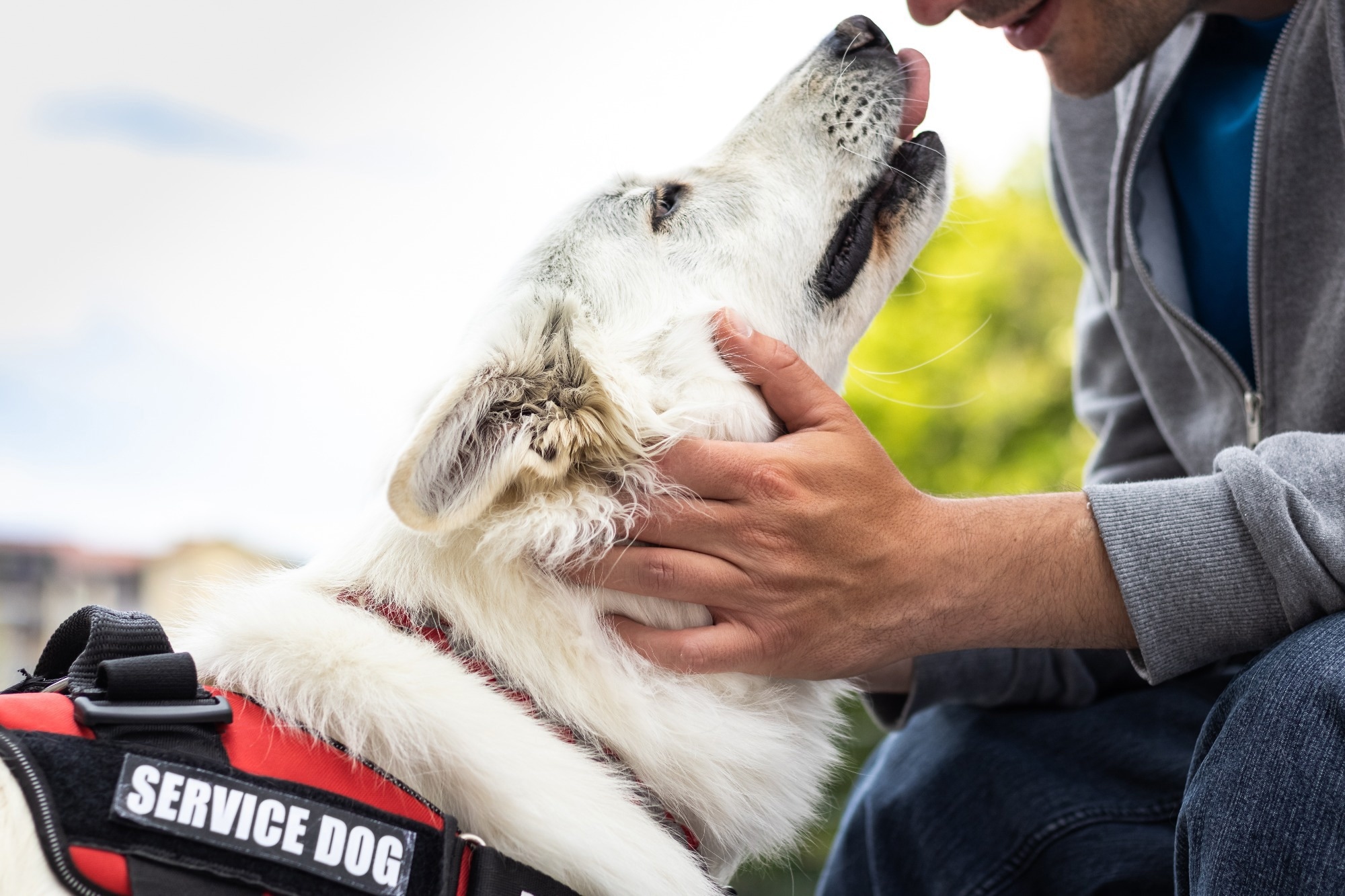In a recent study published in Frontiers in Allergy, researchers investigated whether dogs could detect potential stress-related volatile organic compounds (VOCs) in the breath of trauma survivors (54% with post-traumatic stress disorder (PTSD)] subjected to individualized trauma signals.
 Study: Can scent-detection dogs detect the stress associated with trauma cue exposure in people with trauma histories? A proof-of-concept study. Image Credit: 24K-Production/Shutterstock.com
Study: Can scent-detection dogs detect the stress associated with trauma cue exposure in people with trauma histories? A proof-of-concept study. Image Credit: 24K-Production/Shutterstock.com
Background
PTSD, a mental health illness, is marked by ongoing stress responses to life-threatening situations. Service-related dogs are supplemental treatments permanently placed with patients and trained to assist them.
Evidence indicates that service dog use leads to considerable long-term reductions in PTSD symptomatology, with intrusion and hyperarousal symptoms having the highest impact. Dogs have unique skills to detect stress volatiles, which may benefit predatory species.
Chronic amygdala and stress response overactivity are hallmarks of PTSD and anxiety disorders, with the sympathetic-adreno-medullar (SAM) and hypothalamic-pituitary-adrenal (HPA) axes playing critical roles in re-establishing equilibrium.
About the study
In the present study, researchers investigated whether canines could identify early-onset PTSD episodes in breath samples of individuals with prior trauma when exposed to trauma reminders. They explored training dogs to detect the early start of PTSD intrusion and hyperarousal symptoms using olfactory cues.
The team obtained breath samples from 26 individuals aged between 20 and 53 years throughout 40 sessions in the relaxed (control sample) and agitated states due to trauma cue exposures (target sample).
They showed two smell-detecting hounds of donor samples in the two alternative forced choice (2AFC) discriminating and no/yes detection tasks.
The researchers used the Signal Detection Theory (SDT) to evaluate the dogs' sensitivity, specificity, accuracy, and response bias. They sourced human donors from research on the neurocognitive processes underpinning trauma-cannabis usage linkages.
Donors of 19 to 65 years of age were free of adverse mental diseases, reported using the Life Events Checklist (LEC) having had more than one Diagnostic and Statistical Manual of Mental Disorders, fifth edition (DSM-5) category A criteria for PTSD, and used more than one gram of cannabis per week for the previous month.
The self-reported post-traumatic stress disorder checklist (PCL-5) evaluated symptom severity and the percentage of individuals likely to suffer from PTSD.
The Clinician-Administered PTSD Scale (CAPS-5) identified PTSD and offered an additional measure for the severity of PTSD symptoms (CAPS-5 symptom count).
The researchers recruited 25 companion dogs of various kinds and began scent-identification training at Dalhousie's Canine Olfaction Laboratory. Two dogs, Callie and Ivy, showed consistently precise performance, indicating that they could recognize the target odor and were prepared to test with donor samples.
The team used the Positive and Negative Affect Schedule (PANAS) and Visual Analog Scale (VAS) to measure donors' emotional states following trauma and cannabis exposure, respectively. Dogs worked two-hour shifts in the laboratory once a week using positive reinforcement training methods.
They investigated the relationship between dog performance and PTSD symptom severity or diagnostic parameters. They also assessed the dogs' reactions to cannabis-related VOCs, correlating donors' cannabis use disorder (CUD) symptom severity and cannabis appetite to trauma cue exposure.
Results
Callie and Ivy achieved 90% accuracy across both sample pairs in the discrimination test, whereas the detection trial yielded 81% and 74% accuracies.
Further investigation of canine olfactory performance concerning human donors' self-documented emotional reactions to trauma reminders revealed that the dogs could detect separate endocrine stress signals.
One dog's performance was associated with the self-documented fear responses of the human donors, whereas the second dog's performance was associated with the donors' self-documented shame reactions.
Based on the associations between dog performances and human donor self-documented measures, the researchers hypothesized that VOCs volatile detected by the dogs developed from the sympathetic-adrenal-medullary axis (adrenaline and noradrenaline) in one of the dogs and the hypothalamus-pituitary-adrenal axis (glucocorticoids) for the second one.
The mean PCL-5 score was 45, which was over the threshold for a probable PTSD diagnosis. Eighteen individuals (69%) scored above the threshold. The CAPS-5 interview validated PTSD diagnosis in 14 (54%).
The mean CAPS-5 symptom count was 11, indicating that the typical donor reported 11 PTSD symptoms. The mean score was 11.4, higher than the threshold for hazardous cannabis usage. Fourteen individuals exceeded the threshold for a probable CUD diagnosis (54%).
Exposure to trauma cues during interviews enhanced donors' negative emotions, particularly state anxiety. Ivy's performance was linked favorably with donors' state anxiety, PANAS negative affect, and several PANAS negative-affect measures.
Callie's performance positively correlated with the trauma cue PANAS "ashamed" item. Both dogs could recognize the target fragrance in various stressful situations.
The study showed that dogs could detect VOCs released by individuals with prior trauma episodes who are distressed due to PTSD intrusion or hyperarousal symptoms.
The study findings are consistent with previous research demonstrating dogs' capacity to detect tension in individuals through olfaction. The researchers broadened the trial to include trauma, with all donors reporting trauma experiences and more than half suffering from PTSD.
They found that dogs may generalize olfactory indicators of this stress reaction, supporting the concept of PTSD-aware dogs.